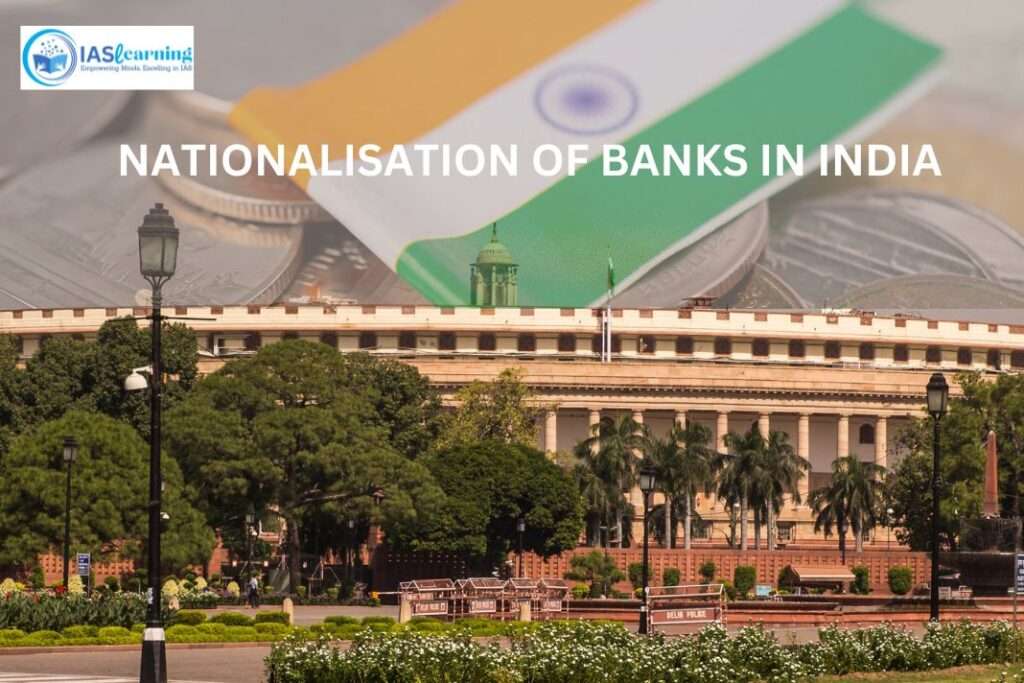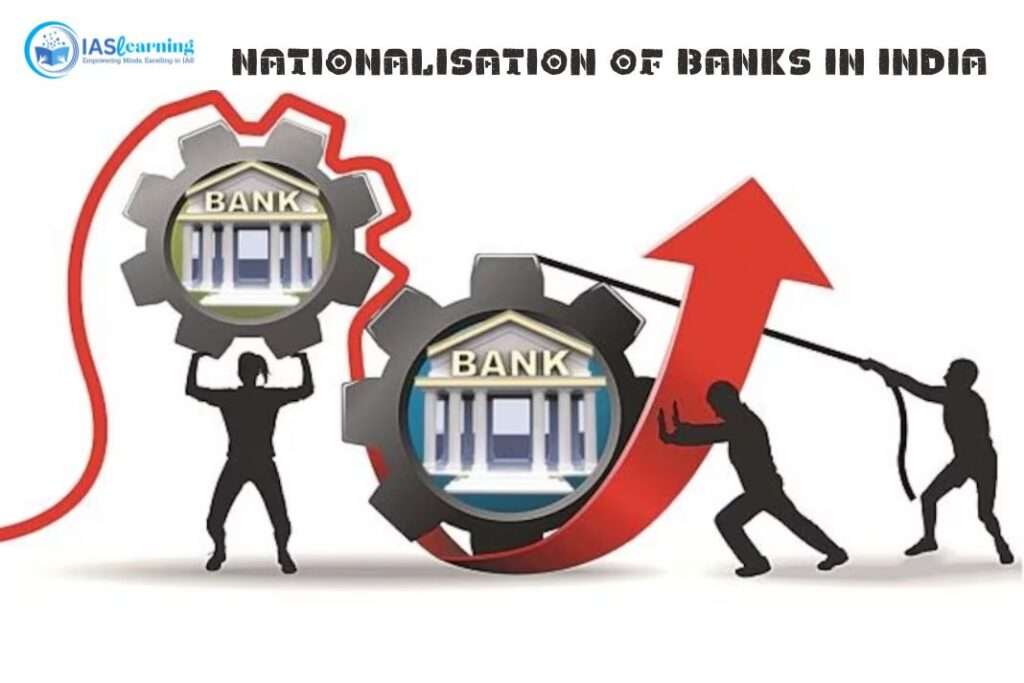Table of Contents
Introduction to Nationalisation of Banks in India
The nationalisation of banks in India was a significant milestone in the country’s economic and financial history. It refers to the government’s decision to take control of major private banks and transform them into public sector banks in order to achieve various socio-economic objectives. This transformative move had far-reaching implications for India’s banking sector, economy, and society as a whole.
Historical Context of Nationalisation of Banks in India
The nationalisation of banks in India was a pivotal event in the country’s economic history, shaped by a combination of historical, economic, and social factors. Understanding the historical context leading up to this transformative decision provides valuable insights into why and how it took place.
Pre-Independence Banking Landscape
Before India gained independence in 1947, the banking sector was dominated by private and foreign banks. The Reserve Bank of India (RBI) was established in 1935 to regulate and oversee banking operations in the country. However, the banking system remained largely unorganized, with limited penetration in rural and underserved areas.

Post-Independence Economic Objectives
After gaining independence, India embarked on a path of economic development with a strong emphasis on self-reliance and social welfare. Key economic objectives included poverty alleviation, industrialization, and reducing regional disparities.
Issues with the Pre-Nationalisation Banking System
Several factors contributed to the push for nationalization of banks:
- Concentration of Wealth: Private and foreign banks predominantly served the interests of a select few, leading to a concentration of wealth and economic power among a small segment of society.
- Limited Access: Banking services were largely inaccessible to rural and economically weaker sections of society, hindering financial inclusion and economic development.
- Neglect of Priority Sectors: Private banks often neglected sectors critical for economic growth, such as agriculture and small-scale industries.
- Lack of Credit Control: The government had limited control over credit allocation, hindering its ability to direct funds to priority sectors.
Steps Toward Nationalisation of Banks in India

The move toward nationalization gained momentum in the 1960s. The government took several steps to lay the groundwork:
- Banking Regulation Act, 1949: This act gave the RBI more powers to regulate and control banks, setting the stage for greater government influence.
- Establishment of National Credit Council: The National Credit Council was set up to coordinate and direct credit policies in alignment with economic priorities.
- Social Control of Banks: The government began to exert more control over private banks, including imposing lending quotas to sectors like agriculture.
Nationalization of Banks: 1969 and 1980
In 1969, the Indian government took a historic step by nationalizing 14 major private banks. This move was followed by the nationalization of an additional six banks in 1980. These actions were motivated by the desire to achieve greater control over the banking sector, expand access to banking services, and direct credit toward priority sectors.
Key Objectives of Nationalisation of Banks in India

The nationalization of banks in India, initiated in 1969 and further expanded in 1980, was driven by several key objectives aimed at transforming the country’s banking sector and fostering socio-economic development. These objectives were instrumental in shaping the nationalization policy and guiding its implementation. Here are the primary objectives:
- Promoting Financial Inclusion
One of the foremost objectives of bank nationalization was to promote financial inclusion by ensuring that banking services reached every corner of the country, including rural and underserved areas. By expanding the branch network to remote regions, nationalized banks aimed to bring the benefits of banking to a broader segment of the population.
- Directing Credit to Priority Sectors
Nationalized banks were expected to play a crucial role in directing credit to priority sectors vital for India’s economic development. These sectors included agriculture, small-scale industries, and exports. By channeling credit into these areas, the government aimed to stimulate economic growth, create employment opportunities, and reduce poverty.
- Controlling Concentration of Wealth
Private and foreign banks in pre-nationalization India were often accused of catering primarily to the interests of a select few, leading to the concentration of wealth and economic power in the hands of a privileged minority. Nationalization sought to mitigate this concentration by making banking services more equitable and accessible to a broader cross-section of society.
- Achieving Social Welfare Goals
Nationalization aligned with India’s commitment to social welfare and equitable economic development. By making banking services more affordable and accessible, the government aimed to uplift marginalized and economically weaker sections of society, thereby promoting social justice and welfare.
- Enhancing Government Control
Nationalization enabled the government to exert greater control over the banking sector. This control extended to policy formulation, credit allocation, and financial regulation. It allowed the government to align banking policies with broader economic objectives and social welfare goals.
- Preventing Concentration of Economic Power
By bringing major banks under public ownership, nationalization aimed to prevent the undue concentration of economic power in the hands of a few influential business interests. This was seen as a means of ensuring that banking resources were used for the benefit of the nation as a whole.
- Strengthening Financial Stability
Nationalized banks were expected to contribute to financial stability by adhering to prudent lending practices and maintaining the integrity of the banking system. This was particularly important during periods of economic volatility and external shocks.
- Empowering the Government to Direct Economic Policies
With a substantial stake in the banking sector, the government could effectively implement monetary and credit policies to support its economic and development objectives. Nationalization provided the necessary tools to execute these policies.
Key Steps in Nationalisation of Banks in India

The process of nationalization involved the following key steps:
- Legislative Framework: The Banking Companies (Acquisition and Transfer of Undertakings) Act, 1970, and the Banking Companies (Acquisition and Transfer of Undertakings) Act, 1980, provided the legal framework for the nationalization of major private banks.
- Identification of Banks: In 1969, 14 major banks were nationalized, which accounted for approximately 85% of the country’s banking assets. In 1980, an additional six banks were nationalized.
- Compensation: The government compensated the shareholders of the nationalized banks at a fair price determined through a well-defined process.
Impact and Significance
The nationalization of banks had several significant impacts:
- Expansion of Banking Services: The reach of banking services expanded significantly, with the establishment of branches in remote and rural areas, contributing to financial inclusion.
- Credit Prioritization: Banks began focusing on priority sectors like agriculture, small-scale industries, and exports, which contributed to the growth of these sectors.
- Stability and Control: Nationalization ensured greater financial stability and control over the banking sector, which played a crucial role during economic crises.
- Social Equity: It promoted social equity by providing banking services and credit facilities to previously underserved sections of society.
However, it’s important to note that nationalization also brought challenges, such as bureaucracy, inefficiency, and political interference, which required continuous reforms and improvements in the banking sector.
Conclusion
The nationalisation of banks in India was a landmark decision that reshaped the country’s financial landscape, focusing on financial inclusion, economic development, and social equity. Over the years, the banking sector has continued to evolve, striking a balance between public ownership and efficiency, while striving to meet the diverse financial needs of India’s vast population.
FAQs
1. What is bank nationalization in India?
- Bank nationalization in India refers to the government’s decision to acquire a significant stake in private banks, transforming them into public sector banks. This move aimed to achieve socio-economic objectives, including financial inclusion and economic development.
2. When did bank nationalization take place in India?
- The first major wave of bank nationalization occurred in 1969, when 14 major private banks were nationalized. This was followed by another round of nationalization in 1980, involving six additional banks.
3. What were the main objectives of bank nationalization in India?
- The key objectives of bank nationalization included promoting financial inclusion, directing credit to priority sectors, controlling the concentration of wealth, achieving social welfare goals, enhancing government control over the banking sector, and preventing the concentration of economic power.
4. How did bank nationalization promote financial inclusion?
- Bank nationalization led to the expansion of banking services, including the establishment of branches in rural and underserved areas. This made banking services more accessible to a broader segment of the population.
5. Which sectors benefited from the directed credit policies of nationalized banks?
- Nationalized banks were directed to extend credit to priority sectors such as agriculture, small-scale industries, and exports. These sectors received increased funding to stimulate economic growth and job creation.
6. Did bank nationalization impact the concentration of wealth in India?
- Yes, bank nationalization aimed to mitigate the concentration of wealth by making banking services more equitable and accessible. It sought to reduce the economic disparities prevalent in pre-nationalization India.
7. How did bank nationalization contribute to social welfare goals?
- Bank nationalization aligned with India’s commitment to social justice and welfare. By providing affordable banking services to marginalized sections of society, it promoted financial inclusion and social empowerment.
8. Did the government gain greater control over the banking sector through nationalization?
- Yes, nationalization allowed the government to exert greater control over the banking sector, including policy formulation and credit allocation. It provided the means to align banking policies with broader economic objectives.
9. What role did nationalized banks play in enhancing financial stability?
- Nationalized banks were expected to contribute to financial stability by adhering to prudent lending practices and maintaining the integrity of the banking system, especially during periods of economic volatility.
10. How did bank nationalization empower the government to direct economic policies? – With a substantial stake in the banking sector, the government could effectively implement monetary and credit policies to support its economic and development objectives, ensuring that banking resources were used for the nation’s benefit.
